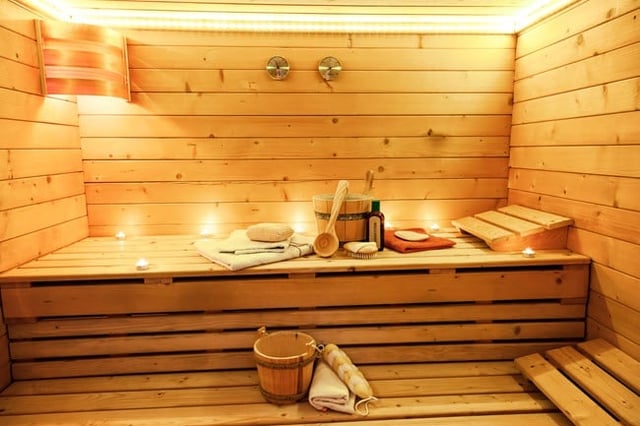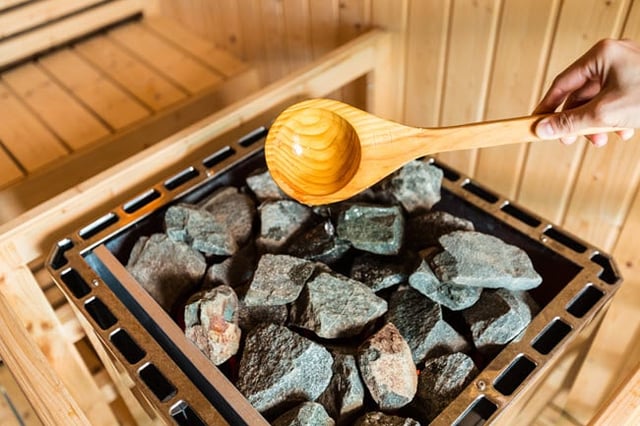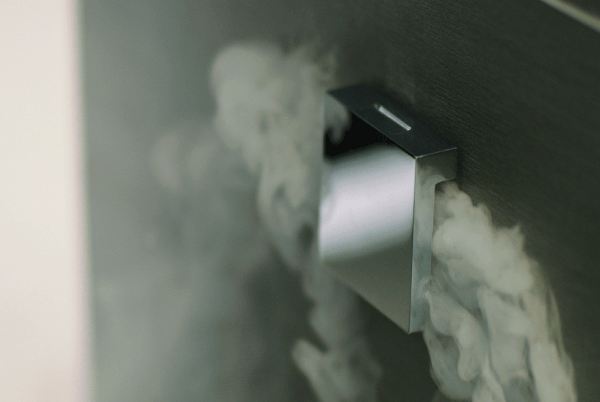How a Steam Shower Differs From a Sauna
Do you know the difference between a steam shower and a sauna?
The terms “steam shower” and “sauna” are often used interchangeably. The two systems are actually quite different from one another, both in how they work and in the potential therapeutic benefits they provide. Let's explore how steam showers and saunas differ from one another.
Steam Shower vs. Sauna Construction

The inside of a steam room looks very different than that of a sauna. Saunas - as you can see in the photo above - are traditionally constructed from kiln-dried wood (often cedar or spruce) that can withstand the much higher temperatures and lower humidity. LiveStrong.com elaborates:
"...Wood absorbs moisture, which not only keeps the surfaces cooler but also helps pull humidity out of the air."

Steamrooms, on the other hand, are constructed from ceramic tiles, glass blocks, or other waterproof, nonporous materials which are conducive to a moist environment.
More importantly, given today’s shrinking floor plans, a steam shower can easily be incorporated into an existing shower footprint (see Yes, You Can Have a Steam Shower in a Small Bathroom); whereas a sauna requires a separate, dedicated room and additional bathroom real estate.
Steam Shower Generator vs. Sauna Heater
One significant difference is where the equipment is placed.
A steamroom or steam shower has a steam generator located outside the room; a sauna's heater is located inside. The generator infuses steam into the room as a rejuvenating mist that envelopes you. A sauna generates intense heat from a traditional rock-laden stove. Some more modern saunas produce heat via an infrared heating system.

Saunas often provide water to pour over the rocks to increase the humidity in the sauna, however not to the extent of a steam room according to Livestrong.com in Sauna vs. Steam Room.
Steam Shower vs. Sauna Temperature
The main difference between a sauna and a steam shower has to do with temperature and atmosphere:
- Steam showers are commonly maintained between 105°F and 115°F with roughly 100 percent humidity.
- Saunas operate at a much higher temperature, ranging between 160°F and 200°F with very little humidity (typically between 10 percent and 20 percent) according to HealthyLiving.azcentral.com in Sauna vs. Steam Room Health Benefits.
In discussing why such extremes of temperature produce similar health benefits, Thomas DeLauer in Sauna vs. Steam Room: Which is a Better Choice?, explains that a steam room doesn’t have to be as hot as a sauna. This is because it’s a sealed environment and the humidity makes the user feel warmer without needing the extreme sauna heat.
The difference in humidity levels is why sometimes people refer to steam showers as “wet” and saunas as “dry” forms of heat therapy.
Saunas and Steam Showers Deliver Wellness Benefits
Both steam showers and saunas can help ease muscle tension and relieve stress at the end of a chaotic day.
Likewise, both may improve circulation and, of course, promote sweating, which opens up the pores and cleanses the skin.
Both steambaths and saunas are great therapies after a workout, as both increase blood flow, which delivers more nutrients to the muscle. It also sends more oxygen to the muscle, which aids in recovery.

Both saunas and steam rooms offer similar emotional and physical relaxation benefits according to HealthyLiving.azcentral.com:
"Wet and dry heat simulate sedative effects that generate feelings of calmness and relaxation, and some people who suffer emotional or mood disorder may find relief with regular trips to saunas or steam rooms."
DeLauer elaborates on this similarity, suggesting that the number one reason to use both saunas and steam rooms is because they elevate your mood. He explains that they both interact with a portion of your brain called the dorsal raphe nucleus, which has heat sensitive neurons that, when exposed to extreme heat, creates excess production of serotonin. This is the feel good hormone that controls functions of mood, energy and focus. The serotonin, he says, gives “you that sense of well being…the extra confidence that you need to get through the day, but also stay on track with your diet or your training regimen.”
Both environments are conducive to muscle relaxation which can offer pain relief for muscular injuries such as those from overuse or exercise.
What's Different Between Steam and Sauna Benefits?
Since a sauna is dry, the natural process of evaporation can leave perspiration and toxins to dry on the skin. The moist environment of a steamroom keeps the body perspiring constantly with no chance for sweat to evaporate or to dry on the skin.
According to Andrew Weil, M.D., the author of “8 Weeks to Optimum Health.”
“Unlike the dry heat of most saunas, steam soothes the nasal passages and respiratory tract, relieves congestion and clears the sinuses, I have long recommended steamtherapy for its health benefits and use it frequently myself... It relaxes mind and body and neutralizes stress.”

According to The Health Benefits of Steam Rooms and Saunas, saunas offer these benefits:
The heat from a sauna soothes your nerve endings and warms and relaxes muscles, in turn relieving the tension from your body and minimizing joint pain. This is especially beneficial for those who suffer from illnesses such as arthritis, painful migraines and headaches.
The article contrasts these with the advantages a steam shower can provide:
The steam room helps to open up airways which improves your breathing and alleviates congestion. The wet heat from the steam room thins and opens the mucous membranes in the body, which helps to relieve pressure. This is highly beneficial for those that suffer from asthma and bronchitis, as it helps with sinus relief.
The steam room also increases metabolism and can aid with weight loss. The steam room causes you to sweat, which means that your body is losing water. As water makes up a large part of your body weight, the emission of the sweat will cause you to lose a few pounds. The sweat also helps to remove toxins and cleanses the body.
Here's a perspective on steam vs. sauna which comes from comments on BlogTour Blogger Linda Holt's article titled Getting Steamy with MrSteam:

However, if you can’t tolerate hot humid environments, the sauna is a better alternative.
If you're concerned about dry skin, you'll prefer the steam shower. That's according to Sauna vs. Steam Room: Which is Better?
"The steam shower is great for people with dry skin, who might suffer in a dry sauna. If your only intention is to sweat as much as possible, then consider that some people believe that you sweat more in a dry sauna, so perhaps that would be the better choice."
For more insights on skincare, read Get Your Glow Back with Steam Therapy.
Or, read more about the benefits of steam showers in MrSteam Helps You Get Into Shape and 44 Benefits of Steam Bathing.
And for steam bathing tips, read Steam Bathing 101: Seven Steps For an Effective Steam Bath.
Sauna Watchout: Stay Hydrated!
The dry heat of the sauna can lead to dehydration. So be sure to drink plenty of water before and after using a sauna.

For both steam shower and sauna, try limiting your bathing time to 10 to 15 minutes the first few times to get used to the experience.
If you have any health concerns, have high blood pressure or are pregnant, please be sure to talk to your healthcare provider to make sure using a steamroom or sauna is safe for you.
Steam Shower or Sauna: Which is Best for You?
Steam showers and saunas differ from several perspectives. In the end, the choice between the two - low-heat/high-moisture environment (steambath) and a high-heat/low-moisture enclosure (sauna) - is a matter of your personal preference and health needs.
The following chart should help you to compare the two:
Steam Room |
Sauna |
|
| Construction | The steam shower can be constructed within your current shower enclosure; no need for an additional room |
A sauna requires the construction of a separate room outside of any existing bathrooms. |
| Treatment |
A steam room is generally designed for very wet and hot health treatment. |
Saunas offer dry sessions. |
| Walls |
Usually made of ceramic tiles, glass blocks, or other waterproof, nonporous materials which are conducive to a moist environment |
Made of wood |
| Head Generation |
Steam rooms have an external steam generator that can be located up to 6 feet away from the steam shower itself. |
Saunas usually have a heater located inside to generate heat |
| Temperature | Typically between 115 to 120° F |
Typically between 158 °F - 212 °F. Because the heat is so extreme, it is advised to check with your doctor before using a sauna. |
| Primary Difference in Benefits | Soothes respiratory ailments, opens up airways and helps with congestion. | Helps with heavy duty detoxification. |
| Risks | Symptoms of too much heat include dizziness in individuals with low blood pressure, vertigo, rapid heartbeat or excessive thirst. |
Sudden humidity may sometimes scald bathers if the room is too hot. A session in a sauna may lead to excessive thirst. |
| Preferable for | People who cannot endure dry heat generally prefer steam rooms. |
People who don’t like moist heat may prefer dry heat sessions in a sauna. |
| Humidity | Very high. Typically close to 100% |
Dry. |
| Use of Towels | Towels are generally not used in private steam rooms but the rules of etiquette vary. They can aid in comfort when used to sit on. Towels are recommended in public steam rooms like those at the gym. |
While nudity is common in saunas, towels may be used, especially to avoid sitting on hot wooden benches. |
Which do you prefer? Let us know in the comments.
Note: This article was originally published on July 16, 2014 and has been updated.

 SEARCH
SEARCH
 FIND A DEALER
FIND A DEALER








